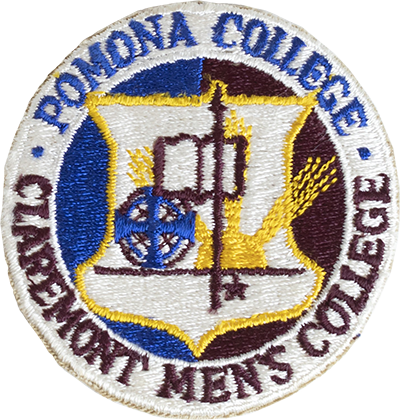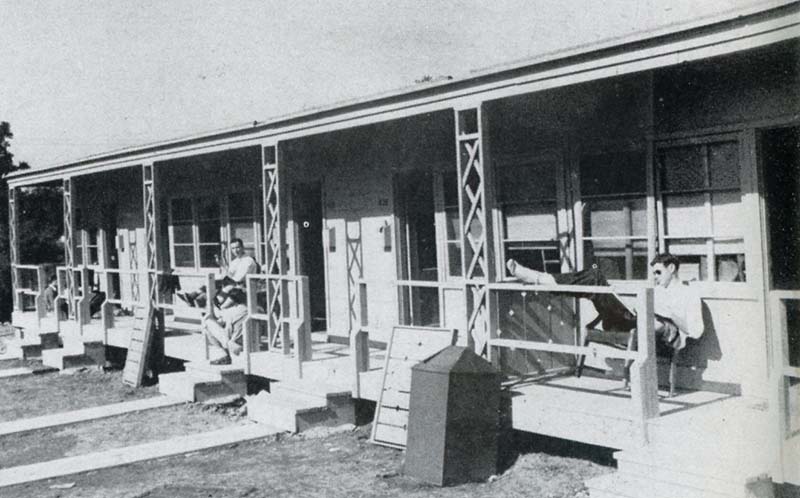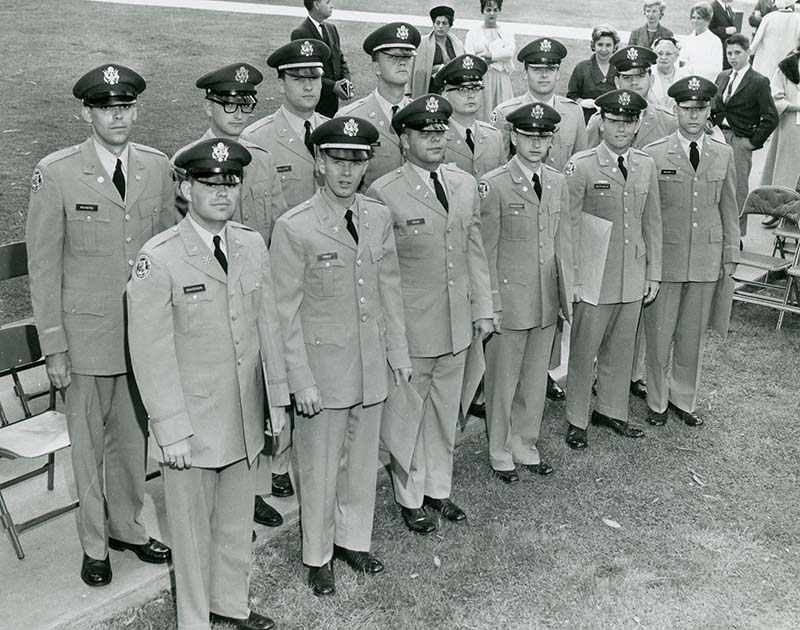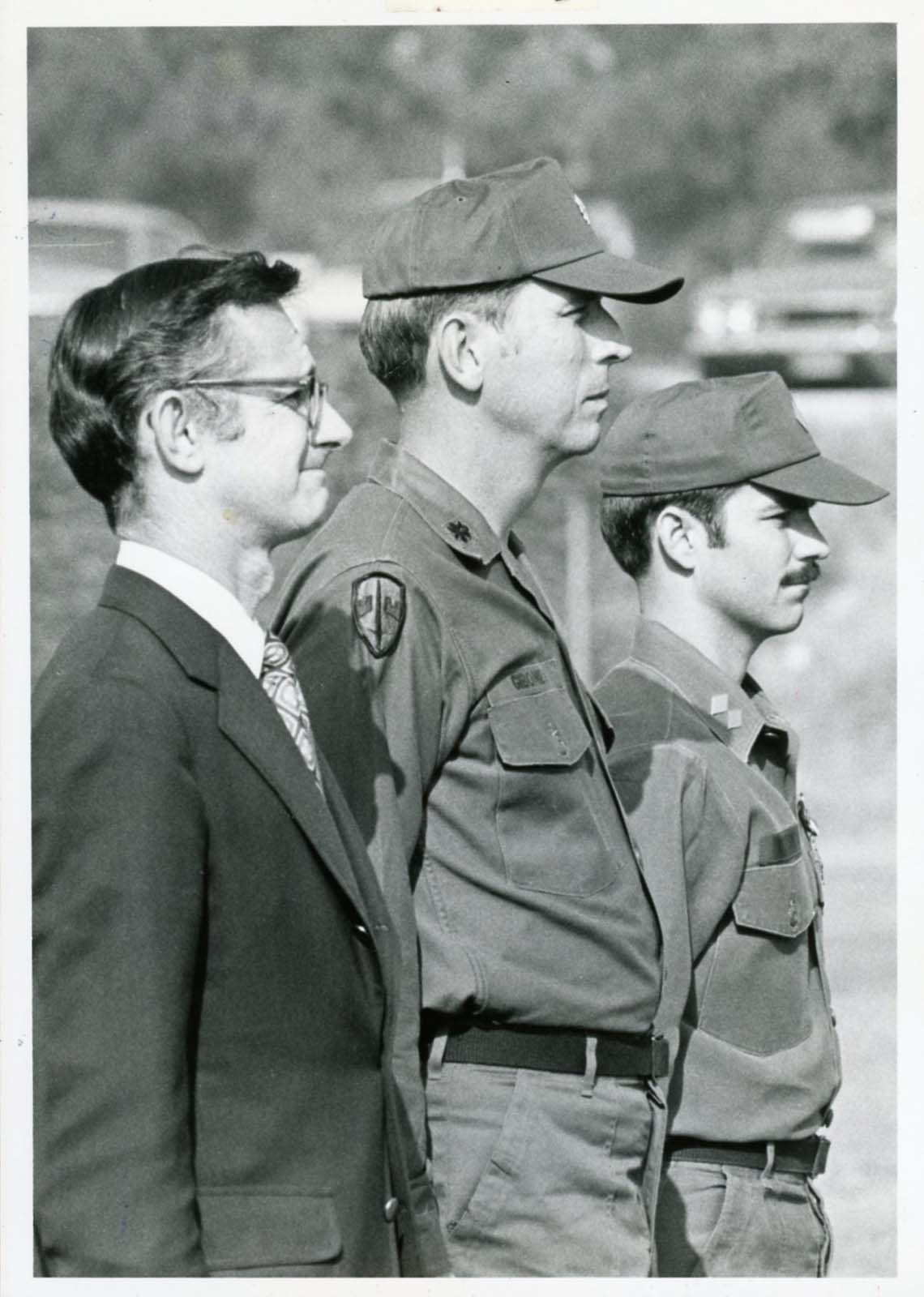EXHIBIT PREVIEW
Veterans and the ROTC at CMC
 The Pomona-CMC ROTC unit in formation on Pomona College’s Alumni Field.
The Pomona-CMC ROTC unit in formation on Pomona College’s Alumni Field.The sixth exhibition in the 75th Anniversary history series, Veterans and the ROTC at CMC, examines the military history of Claremont McKenna College with a focus on the College’s veteran students and faculty, the founding and lasting impact of the ROTC program on the CMC campus, and the Vietnam War era of the 1960s and 1970s through the lens of CMC and the larger Claremont Colleges consortium.
The CMC Digital Archives
Join with Claremont McKenna College as we celebrate our vibrant 75-year history. Reflecting back on the College’s modest origins will lead to perspectives on the College’s current success and will inform the College’s aspirations for the future.
The 2021-22 academic year will be spent commemorating the milestones of the last 75 years in monthly exhibitions that will focus on faculty, students, campus buildings, presidents, coeducation, research institutes, the role of veterans, and others.
The Pomona-CMC ROTC Program
The history of Claremont McKenna College’s Reserve Officer’s Training Corps began long before the College’s founding in 1946, and in fact, is one of the oldest in the nation. Military training commenced in 1916 on the Pomona College campus during World War I, which also included the short-lived Student Army Training Corps (SATC) initiated in May 1918. Pomona College contracted with the government to receive two SATC companies and used its facilities to train newly enlisted young men for military service and to provide military instruction. The units were demobilized immediately after the Armistice was signed in November 1918, and members of the Corps were offered the opportunity to remain at Pomona College as regular students. Following the war, officer training remained an important program at Pomona and the College was officially authorized an ROTC unit by the War Department at the end of 1918.

SATC cadets march along College Avenue during Armistice Day at Pomona College, 1918. In the midst of the 1918 influenza pandemic, notice the cadets wearing cloth face masks to prevent illness.
The G.I. Bill and Early Campus Veterans
At its founding, the Claremont Undergraduate School for Men’s student body stood at 86 men, many of whom were veterans returning from service during World War II. The Servicemen’s Readjustment Act, commonly known as the G.I. Bill of Rights, was passed in June 1944 and saw millions of dollars poured into higher education. The majority of the College’s initial registrants enrolled on the G.I. Bill seeking to pursue a college degree while readjusting to civilian life. Several of the Men’s School’s founding faculty members were also returning veterans.

President George C.S. Benson and Professor Harold F. McClelland watch military exercises during ROTC Summer Camp at Fort Lewis, Washington. Above, right: Temporary wooden dormitories were completed in December of 1946 and provided housing for the College’s veteran students.
The Vietnam War Era
From the start, CMC showed a strong commitment to its Army ROTC program. Dozens of CMC graduates served in the Vietnam War, including William V. Crouch ’63, who was commissioned in June 1963 and served two tours in Vietnam. In the fall of 1994, General Crouch received his fourth star and was named commander-in-chief of the United States Army in Europe. Crouch can be seen here (second row; third from left) with other cadets during the 1963 ROTC Commissioning Ceremony.

Deborah Hasty ’78 at the ROTC Commissioning Ceremony. Hasty was CMC’s first woman student to receive ROTC commissioning honors.
ROTC in the Coeducation Era
Emerging out of the war era and backed by the majority of faculty, students, and trustees through the times of student unrest, the ROTC program gained strength throughout the 1970s, even after the cessation of hostilities in Vietnam and the end of the draft. ROTC became increasingly a matter of free choice for students desiring personal growth, career opportunities, exposure to the military, or the chance to win an Army commission. As in the past, the ROTC program continued to offer distinctive bonding for its participants and CMC, was attractive to the kind of young men (and soon women) considering a career in the Army.
Fostering New Generations of Leaders
Over the last four decades, ROTC has been fully reconciled and reintegrated into faculty culture with the assistance of faculty members over the years. Faculty members such as Ward Elliott and others devised an academic enrichment program in international relations and strategic studies, keyed to ROTC programs throughout the country, that would further supplement the education of ROTC students considering a military career. In 1982, the Secretary of the Army invited President Jack Stark to serve a two-year term as a member of the Army Advisory Panel on Reserve Officer Training Corps–a fellow member of the panel was then-Brigadier General Norman Schwarzkopf. On May 13, 1984, George Benson gave the ROTC commissioning ceremony speech stressing the value of an ROTC commission as preparation for success in the civilian world.
Visit Veterans and the ROTC at CMC
The Archives consulted a variety of sources in compiling this exhibit and are indebted to those historic resources, most notably, Commerce and Civilization, Claremont McKenna College: The First Fifty Years 1946-1996 by Kevin Starr.

